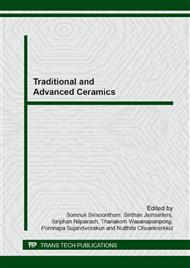p.41
p.47
p.62
p.68
p.73
p.79
p.85
p.91
p.97
Foam Glass Development Using Glass Cullet and Fly Ash or Rice Husk Ash as the Raw Materials
Abstract:
The aim of this work is to study the recycling of glass cullet (waste glass), fly ash, and rice husk ash as the foam glass, a porous construction material having high compressive strength but low density, which are similar to the light weight brick. The foam glasses were prepared by mixing the ground glass cullet/ash mixtures with calcium carbonate (foaming agent) at 1 wt% and sodium silicate solution (binder) at 10 wt%, and then compacted into the rectangle shapes (30 cm × 30 cm × 7cm) which were fired at 650 °C for 30 min, and then for 1 hour at 750, 800, 850, or 900 °C. The sources of glass cullet were art glass factory and glass window industry. The percentages of ash in the ground glass cullet/ash (fly ash or rice husk ash) mixtures were 20, 40, and 60 wt%. The results showed that the foam glass that was made from 80wt% window glass/ 20wt% fly ash and fired at 750 °C had the most suitable properties for being produced commercially because it had good alkaline resistant, and the compressive strength and degree of water absorption better than the light weight brick (G2-type and G4-type autoclaved aerated concrete) while the density was similar to G2-type but lower than G4-type. The compressive strength, density, and degree of water absorption of this foam glass were 59.9 kg/cm2, 421 kg/m3, and 2.1 % respectively. Furthermore, as of September 2013, the total production cost (materials, labor, energy, etc.) of this foam glass is about 16 baht per piece (20 cm × 60 cm × 7.5 cm) which is 12.5 to 43.75% lower than the wholesale price of a light weight brick (18-23 baht per piece for G2-type and G4-type autoclaved aerated concrete).
Info:
Periodical:
Pages:
73-78
Citation:
Online since:
April 2014
Authors:
Keywords:
Price:
Сopyright:
© 2014 Trans Tech Publications Ltd. All Rights Reserved
Share:
Citation:


